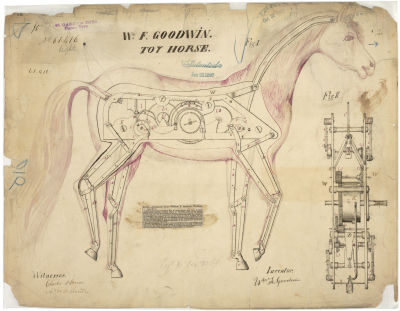
William Farr Goodwin was a diverse inventor. Two of his earlier inventions were for toys, the first of these being for a Mechanical Horse, then later a Walking Doll.

UNITED STATES PATENTS
Patent Number 61416 Goodwin Jan. 22, 1867 . See full patent for the Mechanical Horse here.
Later on in 1876, we see reference to Goodwin in providing some inventions to exhibitors at the Philadelphia Centennial Exhibition.
AGRICULTURAL IMPLEMENTS AT THE PHILADELPHIA EXHIBITION.
Otago Witness 14 Oct 1876, p18The American display of thrashing machinery is extensive, and presents many features of novelty and interest to an Englishman. The construction of the thrashing machinery is, in many respects, totally different from our [English] inventions ; but, as is usually the case, the inventions are suitable, or believed to be suitable, to the work they are made for. ………………………
……..The Screw Mower and Reaper Company exhibit a novelty designed by Mr W. Farr Goodwin. This consists in replacing the ordinary gearing by a gun-metal driving wheel on the main shaft, which drives a worm on the crank shaft ; thus we have very simple gearing and direct action. Undue wear and friction, are avoided by running the gun-metal wheel in oil ; the cover or box for this wheel makes a receptacle for the oil. This, we have no doubt, prevents that friction which we should have expected from such a principle. . We are told that machines could be produced which had cut large quantities of grain, and been working for long periods ; but we object to the oiling box arrangement, since farmers are often so careless that they would fail to clean out properly when done with, or to renew the oil before beginning to work. The company claim, and we think with reason, durability and simplicity. It is clear that the action is; fairly direct, and that the necessary motions are produced with the minimum of gearing. Under trial it made very good work, but the draught on the dynamometer was heavy ; this seems to indicate friction. Another novelty was shown by the National Ironworks Company, New Brunswick, New Jersey ; this is also the invention of Mr W. Farr Goodwin, who appears quite a genius for producing novelties. This, the Reciprocating Screw Mowing Machine, is his latest invention. The merits claimed are, that it has no gear or cog wheels of any kind, no crank movement, and no journal or bearings that revolve, save the main axle. These are certainly startling alterations from all our preconceived notions of a mowing machine, and we are bound to admit that the machine made good work, cutting both the standing and laid crop well. — The London Field.
What is more interesting, is that one of those companies where one of his inventions was manufactured, namely the National Ironworks Company, was also making a mechanical horse for display.
Iron – June 3, 1876, London, Middlesex
Mechanical horses and Men.-A mechanical horse is being made at the National Ironworks, New Brunswick, New Jersey, which is quite a curiosity in its way, and is to be on exhibition at the Centennial. The life-size model has been operated satisfactorily to all who have seen it. Every movement of the horse is as natural as life. It walks, and each joint of the leg is put in its proper motion, while the neck and head bob in appropriate unison, and yet the simplest mechanism is used, being nothing more than a few pulleys and one or two belts, the latter corresponding with the tendons of the natural animals. There are also four steam men being manufactured at Munn's machine shop. These men are for exhibition at the Centennial.
"In different sizes and kinds of toys, various means will be employed to impart the rotary movements to the cranks W. In hobby horses of large size, the spring or driving power will be mounted on the axle of a wagon or cart, and the rotating motions imparted to the cranks B' by means of a chain or belt passing over a pulley on the wagon, and over a pulley on the shaft B in the hobby horse. This means of operating the cranks may also be used in small toys, when wagons arc attached to them, as it would be cheaper, there being no machinery in the toy but the shafts B, and cranks B', and the pulleys and connecting-chain or rod, by which the cranks are operated, and the means by which the head and tail are operated, all the driving apparatus used to impart the rotary motion to the shafts B and cranks B' being mounted on the wagon, the rotary motion being communicated to the pulleys in the toy by means of chains or belts, as before described."

Patent Number 81491 – Goodwin Aug. 25, 1868 Automatic Toy . See full patent here.

Patent number: 198604
Filing date: Mar 27, 1877
Issue date: Dec 25, 1877
Filing date: Feb 9, 1877
Issue date: Nov 13, 1877
Patent number: 214645
Filing date: Mar 23, 1879
Issue date: 1879
Patent number: 171793
Filing date: Dec 14, 1875
Issue date: Jan 4, 1876
Patent number: 72842
Issue date: Dec 1867